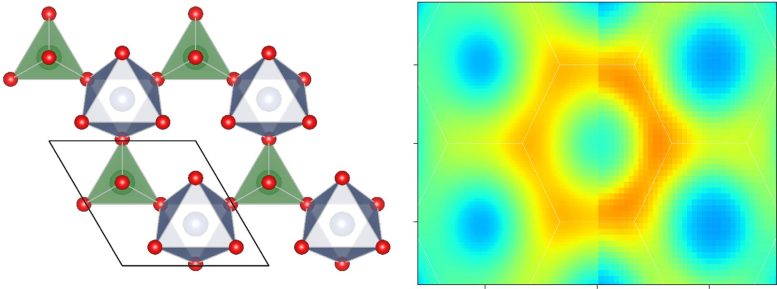
(Left panel) In nickel molybdate crystals made of two parts nickel, three parts molybdenum and eight parts oxygen, nickel ions are subject to both tetrahedral and octahedral crystalline environments, and the ions are locked in triangular lattices in each environment. (Right panel) Crystal electric field spin excitons from tetrahedral sites in nickel molybdate crystals form a dispersive, diffusive pattern around the Brillouin zone boundary, likely due to spin entanglement and geometric frustrations. Left and right halves of the panel show different model calculations of these patterns. Credit: Bin Gao/Rice University
Neutron scattering reveals coherent waves of ‘spin excitons’ in nickelate crystal.
Rice University physicists discovered “spin excitons” in nickel molybdate crystals, a new type of magnetic excitation that can propagate as coherent waves, offering insight into magnetic frustrations in triangular lattices.
Perturbing electron spins in a magnet usually results in excitations called “spin waves” that ripple through the magnet like waves on a pond that’s been struck by a pebble. In a new study, Rice University physicists and their collaborators have discovered dramatically different excitations called “spin excitons” that can also “ripple” through a nickel-based magnet as a coherent wave.
In a study published in the journal Nature Communications, the researchers reported finding unusual properties in nickel molybdate, a layered magnetic crystal. Subatomic particles called electrons resemble minuscule magnets, and they typically orient themselves like compass needles in relation to magnetic fields. In experiments where neutrons were scattered from magnetic nickel ions inside the crystals, the researchers found that two outermost electrons from each nickel ion behaved differently. Rather than aligning their spins like compass needles, the two canceled one another in a phenomenon physicists call a spin singlet.
“Such a substance should not be a magnet at all,” said Rice’s Pengcheng Dai, corresponding author of the study. “And if a neutron scatters off a given nickel ion, the excitations should remain local and not propagate through the sample.”
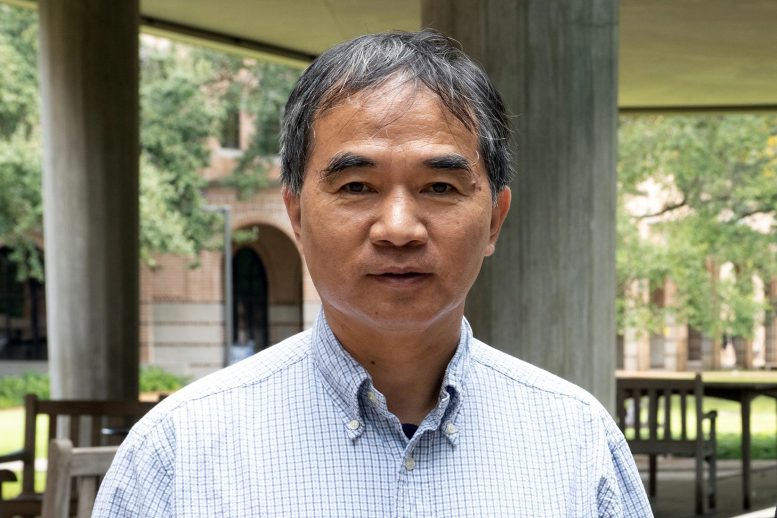
Pengcheng Dai is the Sam and Helen Worden Professor of Physics and Astronomy at Rice University. Credit: Jeff Fitlow/Rice University
Dai and his collaborators were therefore surprised when instruments in the neutron-scattering experiments detected not one, but two families of propagating waves, each at dramatically different energies.
To understand the waves’ origins, it was necessary to delve into the atomic details of the magnetic crystals. For instance, electromagnetic forces from atoms in crystals can compete with the magnetic field and affect electrons inside neighboring atoms. This is called the crystal field effect, and it can force electron spins to orient themselves along directions distinct from the orientation of the magnetic field. Probing crystal field effects in the nickel molybdate crystals required additional experiments and theoretical interpretation of the data from the experiments.
“The collaboration between experimental groups and theory is paramount to painting a full picture and understanding the unusual spin excitations observed in this compound,” said Rice co-author Emilia Morosan.
Morosan’s group probed the thermal response of the crystals to changes in temperature using specific heat measurements. From those experiments, the researchers concluded that two kinds of crystal field environments occurred in the layered nickel molybdate, and the two affected nickel ions very differently.
“In one, the field effect is rather weak and corresponds to a thermal energy of about 10 Kelvin,” said study co-author Andriy Nevidomskyy, a theoretical physicist at Rice who helped interpret the experimental data. “It is perhaps not surprising to see, at few-Kelvin temperatures, that neutrons can excite magnetic spin waves from nickel atoms that are subject to this first type of crystal field effect. But it is most puzzling to see them coming from nickel atoms that are subject to the second type. Those atoms have a tetrahedral arrangement of oxygens around them, and the electric field effect is nearly 20-fold stronger, meaning the excitations are that much harder to create.”
Nevidomskyy said this can be understood as if the spins on the corresponding nickel ions had different “mass.”
“The analogy is that of heavy basketballs that are intermixed with tennis balls,” he said. “To excite the spins of the second type, the heavier basketballs, one must administer a stronger ‘kick’ by shining more energetic neutrons at the material.”
The resulting effect on the nickel spin is called a spin exciton, and one would normally expect the effect of the exciton-producing “kick” to be confined to a single atom. But measurements from the experiments indicated “basketballs” were moving in unison, creating an unexpected sort of wave. Even more surprising, the waves appeared to persist at relatively high temperatures where the crystals no longer behaved as magnets.
The explanation offered by Nevidomskyy and theorist co-author Leon Balents from the University of California, Santa Barbara was: Heavier spin excitons — basketballs in the analogy — bob in response to the fluctuations of the surrounding, lighter magnetic excitons — the analogous tennis balls — and if the interactions between the two types of balls are sufficiently strong, the heavier spin excitons participate in a coherent motion akin to a wave.
“What is particularly interesting,” Dai said, “is that the two kinds of nickel atoms each form a triangular lattice, and the magnetic interactions within this lattice are therefore frustrated.”
In magnetism on triangular lattices, frustration refers to the difficulty in aligning all the magnetic moments anti-parallel (up-down) with respect to their three immediate, nearest neighbors.
Understanding the role of magnetic frustrations in triangular lattices is one of the long-standing challenges that Dai and Nevidomskyy have both been working to address for a number of years.
“It is very exciting to find a puzzle, against one’s expectations, and then feel a sense of satisfaction of having understood its origin,” said Nevidomskyy.
Reference: “Diffusive excitonic bands from frustrated triangular sublattice in a singlet-ground-state system” by Bin Gao, Tong Chen, Xiao-Chuan Wu, Michael Flynn, Chunruo Duan, Lebing Chen, Chien-Lung Huang, Jesse Liebman, Shuyi Li, Feng Ye, Matthew B. Stone, Andrey Podlesnyak, Douglas L. Abernathy, Devashibhai T. Adroja, Manh Duc Le, Qingzhen Huang, Andriy H. Nevidomskyy, Emilia Morosan, Leon Balents and Pengcheng Dai, 12 April 2023, Nature Communications.
DOI: 10.1038/s41467-023-37669-5
Dai, Morosan and Nevidomskyy are members of the Rice Quantum Initiative. Dai is the Sam and Helen Worden Professor of Physics and Astronomy. Morosan is a professor of physics and astronomy, and of chemistry. Nevidomskyy is an associate professor of physics and astronomy. The neutron scattering experiments were carried out by Bin Gao and Tong Chen in Dai’s group in collaboration with instrument scientists at Oak Ridge National Laboratory and ISIS Neutron and Muon Source at Rutherford Appleton Laboratory. Chien-Lung Huang, a research scientist in Morosan’s group, performed the specific heat measurements and analysis.
The research was supported by the Department of Energy (DE-SC0012311), the Welch Foundation (C-1839, C-1818 and C-2114) and the National Science Foundation (2116515). The neutron scattering measurements were performed at the Spallation Neutron Source, a Department of Energy facility operated by the Oak Ridge National Laboratory, and at the United Kingdom’s ISIS Neutron and Muon Source.

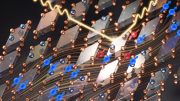
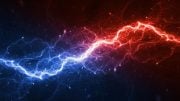
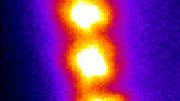
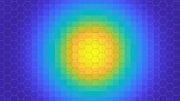


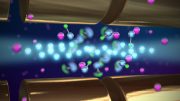
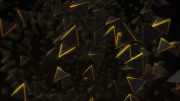
Be the first to comment on "Waves of Wonder: Physicists Unravel Spin Excitons in Nickel Magnets"